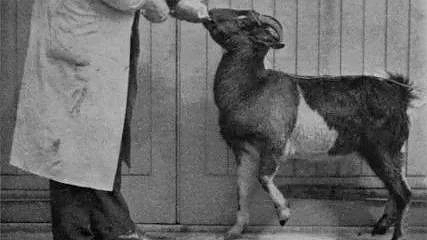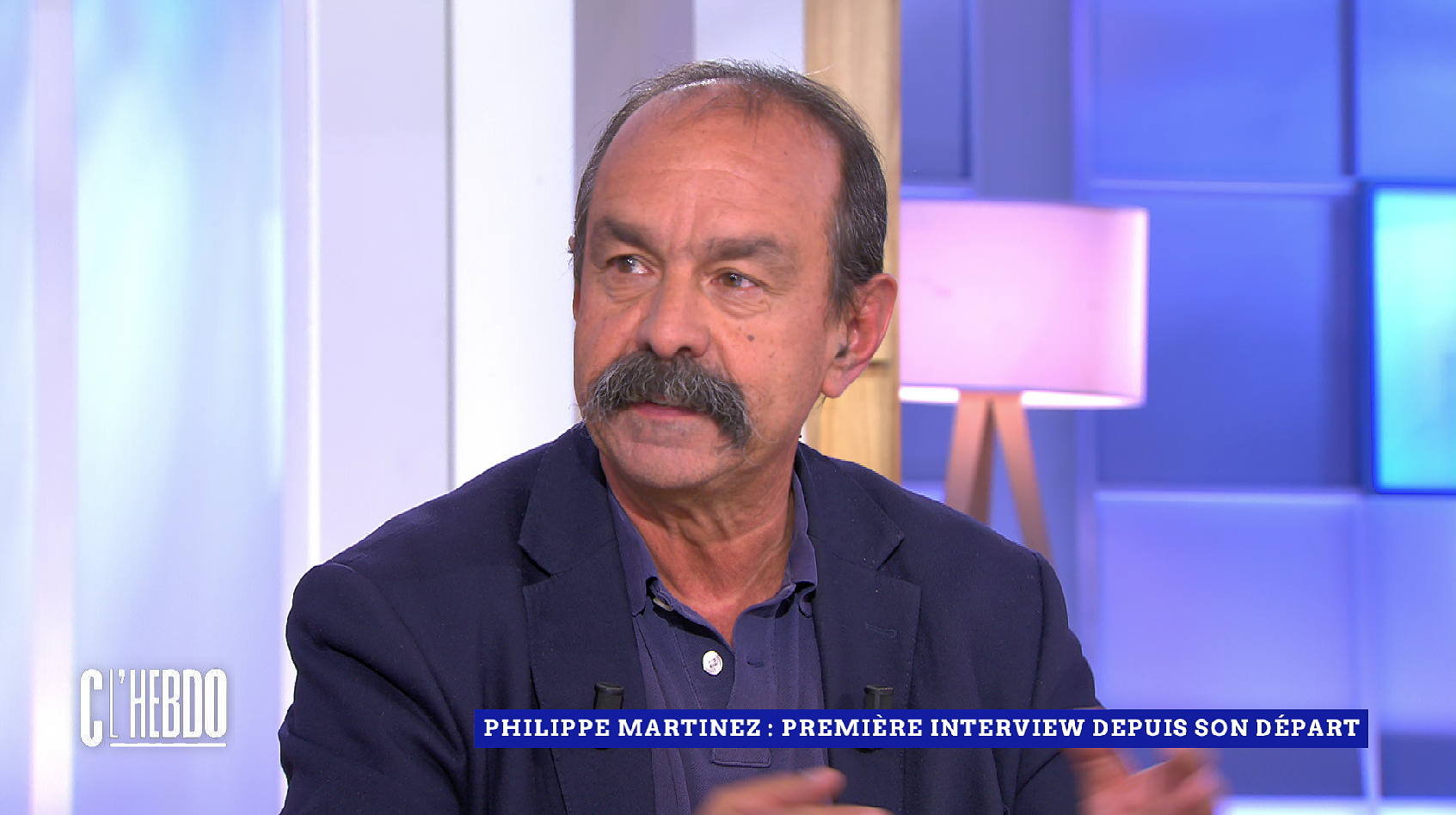Ah! How pretty they were, Mr. Haldane's little goats! And then docile, caressing, allowing themselves to be placed without moving in a hyperbaric chamber... Life not being a tale by Alphonse Daudet, it is nevertheless not for their gentle eyes and their non-commissioned officer's goatee that the Scottish physiologist John Scott Haldane invited them into his experiences. Charged by the Royal Navy to better understand the decompression accidents that affect divers when they come up from the depths, the researcher simply judged that goats were the closest thing to humans, without the fact of inflicting them suffering does not pose an ethical problem.
At least this is how he explained his choice in 1908, in The Journal of Hygiene: while being "the largest animals that we could use and which could be obtained in large numbers", he considered while presenting his work, according to him, goats also have the immense quality of being "stupid and insensitive to pain" but "capable of entering into an emotional relationship with those around them" sufficient for those who are familiar with them to "detect slight anomalies”. The goats will appreciate...
John Scott Haldane's objective: to understand the illness that strikes underwater divers and workers of the depths once they return to the surface. Because in the 19th century, hyperbaric chambers were invented, which reproduced pressures higher than atmospheric pressure found underwater. Medicine uses them first to treat malnutrition, rickets or emphysema.
But the progress made allows, thanks to increasingly efficient pressure chambers, the exploitation of otherwise inaccessible mines, the digging of wells in flooded lands or the manufacture of foundations in the beds of rivers to erect gigantic bridges. At the same time, scuba diving devices are improving, allowing us to explore ever deeper. But as men spend longer and longer stays in these depths and are therefore subjected to significant pressures, a mysterious illness arises: once they return to the surface, some develop what is then called "disease". "caissons", whose symptoms range from simple muscle pain to sudden death.
In 1847, recounts the diver Alain Foret in the preface to a translation of Haldane's text published in 2008, two doctors recounted the observations made during the digging of a coal mine in Douchy, in the north of France. The men descend in 15 minutes, spend 4 hours at a pressure 4.5 times greater than that of the surface, then return in 30 minutes. Out of 64 miners, 14 showed mild symptoms of caisson disease, 16 had serious symptoms (loss of consciousness, severe muscle pain, blurred vision, etc.), and 2 died. “The danger is not in entering a compressed well; (…) it is no longer a matter of staying there for a longer or shorter time, only decompression is to be feared”, already understand the two doctors, who judge that “the unfortunate effects of decompression are a direct result of its speed” . But accidents continue, for example during the construction of the Eads Bridge in Saint-Louis (United States) where out of 600 workers, 119 were seriously injured, including 15 who died.
In Britain, the Royal Navy formed a committee on deep diving in 1905 and tasked Haldane, with Lieutenant Boycott and Diving Inspector Damant, with figuring out how to ensure the safety of divers. Haldane, an expert in the physiology of breathing, is already known for advising miners to descend with canaries to detect the risk of carbon monoxide poisoning early. He is a researcher like the times produced: among other eccentricities, he is said to have carefully and systematically poisoned himself with carbon monoxide, while measuring the oxygen saturation of his blood and noting his sensations... He knows the work by the Frenchman Paul Bert who, in 1878, described the physiological effects of pressure variations and understood that the nitrogen contained in the air breathed by divers and dissolved in their blood returns to its gaseous form upon ascent, and forms bubbles able to block blood vessels.
Haldane obtained an experimental compression chamber which he installed at the Lister Institute in London. Made up of a boiler segment donated by a wealthy industrialist, it is large enough “to contain 3 or 4 people comfortably and to be used for animal experiments for several hours without the need for ventilation”. After placing a few rats, guinea pigs and rabbits there, Haldane convinced himself that their metabolism was too fast to truly suffer from chamber sickness. It needs larger animals to approach human physiology.
85 goats, “ordinary English goats”, writes the researcher, will stay more or less long under varying degrees of pressure. Haldane observes the symptoms they develop: pain, particularly in the legs, temporary or permanent paralysis, dyspnea... He notes that sensitivity to decompression varies greatly from one individual to another, but also depending on the location ( he speaks of a “compartment”) of the body, and that a slow and above all progressive rise allows the lungs to evacuate the nitrogen bubbles. Haldane thus established the first decompression tables, which made it possible to manage the ascent speed and the stops to be made according to the time spent at a given depth. The model, improved over time, is still one of those used by underwater divers today. After his goats, Haldane put his all into it: once his tables were perfected, he wanted to test them himself by diving off the coast of Scotland. Some say he almost drowned, not knowing how to swim. And overboard he also sent his 13 year old son, to show that the tables could be used by inexperienced divers!

 B:SM will break its investment record this year with 62 million euros
B:SM will break its investment record this year with 62 million euros War in Ukraine: when kyiv attacks Russia with inflatable balloons loaded with explosives
War in Ukraine: when kyiv attacks Russia with inflatable balloons loaded with explosives United States: divided on the question of presidential immunity, the Supreme Court offers respite to Trump
United States: divided on the question of presidential immunity, the Supreme Court offers respite to Trump Maurizio Molinari: “the Scurati affair, a European injury”
Maurizio Molinari: “the Scurati affair, a European injury” Irritable bowel syndrome: the effectiveness of low-carbohydrate diets is confirmed
Irritable bowel syndrome: the effectiveness of low-carbohydrate diets is confirmed Beware of the three main sources of poisoning in children
Beware of the three main sources of poisoning in children First three cases of “native” cholera confirmed in Mayotte
First three cases of “native” cholera confirmed in Mayotte Meningitis: compulsory vaccination for babies will be extended in 2025
Meningitis: compulsory vaccination for babies will be extended in 2025 In the United States, a Boeing 767 loses its emergency slide shortly after takeoff
In the United States, a Boeing 767 loses its emergency slide shortly after takeoff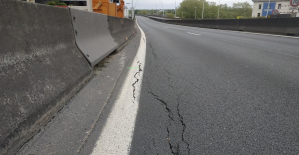 The A13 motorway will not reopen on May 1
The A13 motorway will not reopen on May 1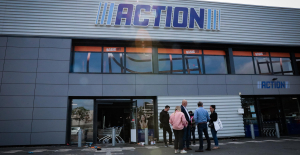 More than 1,500 items for less than 1 euro: the Dutch discounter Action opens a third store in Paris
More than 1,500 items for less than 1 euro: the Dutch discounter Action opens a third store in Paris 100 million euros in loans, water storage, Ecophyto plan… New measures from the executive towards farmers
100 million euros in loans, water storage, Ecophyto plan… New measures from the executive towards farmers Books poisoned with arsenic present in French libraries
Books poisoned with arsenic present in French libraries New York justice returns 30 works of art looted from Cambodia and Indonesia
New York justice returns 30 works of art looted from Cambodia and Indonesia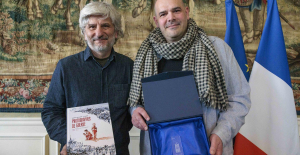 Les Galons de la BD dedicates War Photographers, a virtuoso album on the Spanish War
Les Galons de la BD dedicates War Photographers, a virtuoso album on the Spanish War Theater: Kevin, or the example of an academic failure
Theater: Kevin, or the example of an academic failure Skoda Kodiaq 2024: a 'beast' plug-in hybrid SUV
Skoda Kodiaq 2024: a 'beast' plug-in hybrid SUV Tesla launches a new Model Y with 600 km of autonomy at a "more accessible price"
Tesla launches a new Model Y with 600 km of autonomy at a "more accessible price" The 10 best-selling cars in March 2024 in Spain: sales fall due to Easter
The 10 best-selling cars in March 2024 in Spain: sales fall due to Easter A private jet company buys more than 100 flying cars
A private jet company buys more than 100 flying cars This is how housing prices have changed in Spain in the last decade
This is how housing prices have changed in Spain in the last decade The home mortgage firm drops 10% in January and interest soars to 3.46%
The home mortgage firm drops 10% in January and interest soars to 3.46% The jewel of the Rocío de Nagüeles urbanization: a dream villa in Marbella
The jewel of the Rocío de Nagüeles urbanization: a dream villa in Marbella Rental prices grow by 7.3% in February: where does it go up and where does it go down?
Rental prices grow by 7.3% in February: where does it go up and where does it go down? Even on a mission for NATO, the Charles-de-Gaulle remains under French control, Lecornu responds to Mélenchon
Even on a mission for NATO, the Charles-de-Gaulle remains under French control, Lecornu responds to Mélenchon “Deadly Europe”, “economic decline”, immigration… What to remember from Emmanuel Macron’s speech at the Sorbonne
“Deadly Europe”, “economic decline”, immigration… What to remember from Emmanuel Macron’s speech at the Sorbonne Sale of Biogaran: The Republicans write to Emmanuel Macron
Sale of Biogaran: The Republicans write to Emmanuel Macron Europeans: “All those who claim that we don’t need Europe are liars”, criticizes Bayrou
Europeans: “All those who claim that we don’t need Europe are liars”, criticizes Bayrou These French cities that will boycott the World Cup in Qatar
These French cities that will boycott the World Cup in Qatar PSG: “Immense pride in continuing the adventure in Paris”, relishes Zaire-Emery
PSG: “Immense pride in continuing the adventure in Paris”, relishes Zaire-Emery Breaking: everything you need to know about this sport
Breaking: everything you need to know about this sport NBA: Lakers gain respite, Boston responds to Miami
NBA: Lakers gain respite, Boston responds to Miami Top 14: “a very severe red card”, estimates Labit (French Stadium)
Top 14: “a very severe red card”, estimates Labit (French Stadium)